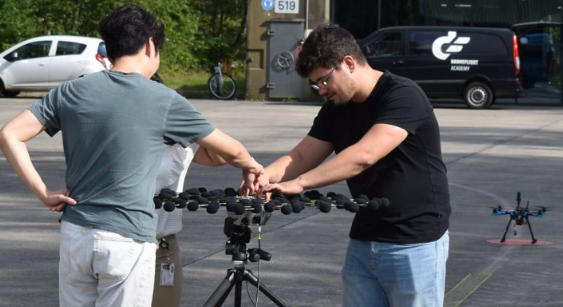The Robotics and Mechatronics Group (UT-RAM) and the Engineering Fluid Dynamics Group (UT-EFD) at the University of Twente conducted successful sound measurements in collaboration with the innovation cluster for unmanned systems, Space53, located at Technology Base. Using a microphone array, they quantified the acoustic emissions of an unmanned aircraft, or drone, during various flight maneuvers. The measurement system can quantify and locate the sound by creating acoustic images of the produced sound. Additionally, the unmanned aircraft is equipped with an experimental framework that allows relevant flight parameters, such as altitude, speed, and position, to be read and synchronized with the sound measurements simultaneously. This framework enables researchers to execute pre-programmed flight paths and maneuvers, significantly improving the repeatability of sound measurements.
Mike Holsheimer, program manager at Space53, emphasizes the importance of these measurements: “In addition to driving innovations in unmanned flight systems, societal acceptance is also a significant concern for us. Especially over densely populated areas, noise pollution can lead to resistance. Thanks to such precise measurements, we can adjust flight routes, altitudes, and speeds to minimize noise pollution. This is a significant breakthrough in the societal acceptance of unmanned aircraft.”
The advanced measurement system enables researchers to accurately quantify aircraft noise emissions, regardless of the type of aircraft, from unmanned drones to electric air taxis and commercial airplanes. The UT-EFD research group conducts extensive investigations into the aeroacoustics of aircraft, as well as those from wind turbines, drones, and ship propellers. For example, in the context of the active EU-funded ENODISE and zEPHYR projects. This research is primarily conducted through experimental studies in the controlled environment of the quiet wind tunnel at the University of Twente. This type of research is of significant importance for the environment and the living environment in the Netherlands because it helps reduce noise pollution, contributing to the creation of a healthier, sustainable, and more pleasant living environment.
Marijn Sanders, Assistant Professor in the UT-EFD group, emphasizes the optimal testing environment at Twente Airport: “Twente Airport is the ideal testing location for sound measurements in the field. The airport is unique due to its low ambient noise level and limited air traffic, providing precise and extensive testing opportunities. Furthermore, there is ample space and flexibility to test experimental innovations and make adjustments as needed if certain aircraft designs or configurations produce excessive noise. The mobile measurement system can be easily adjusted and optimized, allowing for repeated measurements until the desired noise production is achieved.
The noise production of an unmanned flight system is also a significant aspect in other projects of the UT-RaM group, where these systems are employed for removing waste from rivers and delivering tools to people working at great heights. This is especially relevant given UT-RaM’s participation in the recently completed EU project Aerial-core and the ongoing Marie-Sklodowska Curie Project Flyflic. Chiara Gabellieri emphasizes: “Research in designing control systems for autonomous aerial robots is essential to provide efficient and innovative solutions for various sectors. The acoustic assessment of these aerial robots is of great importance, particularly given the UT-RaM group’s focus on human-robot interaction and environmental applications. Additionally, reduced noise production enhances operational efficiency, making unmanned flight systems more suitable for use in densely populated urban areas”.
Twente Airport is part of Technology Base and is the breeding ground for sustainable aviation. Electrically powered aircraft are known for being not only more sustainable but also quieter. Peter Bulckaert, aviation consultant at Twente Airport, states: “There is still room for improvement in reducing noise in both the development of components for electric aircraft and the way they are operated. We are pleased to make our runway and other test facilities available for conducting the necessary tests for these improvements. In the societal acceptance of electric flying, as well, quieter is better, so it is a valuable addition for aircraft manufacturers to optimize both components and flight methods, thereby contributing to a sustainable and quiet aviation.”
For more information visit:




